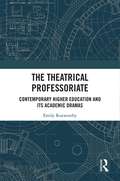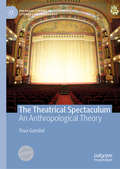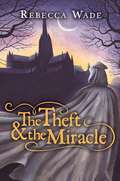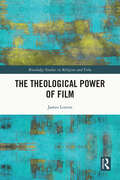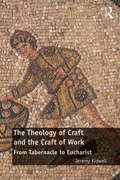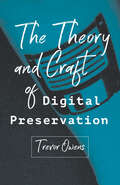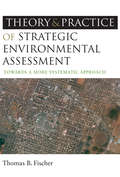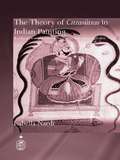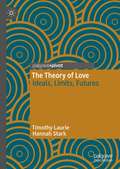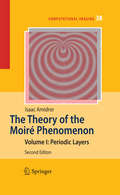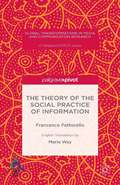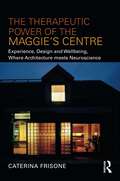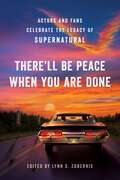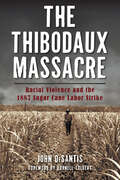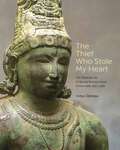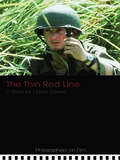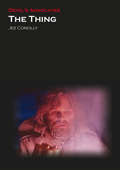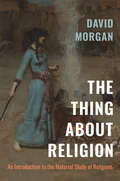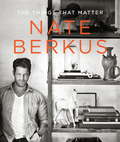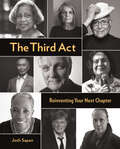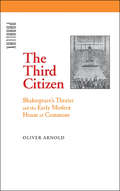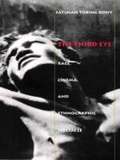- Table View
- List View
The Theatrical Professoriate: Contemporary Higher Education and Its Academic Dramas
by Emily RoxworthyThis book argues that today’s professoriate has become increasingly theatrical, largely as a result of neoliberal policies in higher education, but also in response to an anti-intellectual scrutiny that has become pervasive throughout the Western world. The Theatrical Professoriate: Contemporary Higher Education and Its Academic Dramas examines how the Western professoriate increasingly finds itself enacting command performances that utilize scripting, characterization, surrogation, and spectacle—the hallmarks of theatricality—toward neoliberal ends. Roxworthy explores how the theatrical nature of today’s professoriate and the resultant glut of performances about academia on stage and screen have contributed to a highly ambivalent public fascination with academia. She further documents the "theatrical turn" witnessed in American higher education, as academic institutions use performance to intervene in the diversity issues and disciplinary disparities fueled by neoliberalism. By analyzing academic dramas and their audience reception alongside theoretical approaches, the author reveals how contemporary academia drives the professoriate to perform in what seem like increasingly artificial ways. Ideal for practitioners and students of education, ethnic, and science studies, The Theatrical Professoriate deftly intervenes in Performance Studies’ still-unsettled debates over the differential impact of live versus mediated performances.
The Theatrical Public Sphere
by Christopher B. BalmeThe concept of the public sphere, as first outlined by German philosopher Jürgen Habermas, refers to the right of all citizens to engage in debate on public issues on equal terms. In this book, Christopher B. Balme explores theatre's role in this crucial political and social function. He traces its origins and argues that the theatrical public sphere invariably focuses attention on theatre as an institution between the shifting borders of the private and public, reasoned debate and agonistic intervention. Chapters explore this concept in a variety of contexts, including the debates that led to the closure of British theatres in 1642, theatre's use of media, controversies surrounding race, religion and blasphemy, and theatre's place in a new age of globalised aesthetics. Balme concludes by addressing the relationship of theatre today with the public sphere and whether theatre's transformation into an art form has made it increasingly irrelevant for contemporary society.
The Theatrical Spectaculum: An Anthropological Theory (Palgrave Studies in Literary Anthropology)
by Tova GamlielThis book offers a new mythic perspective on the secret of the allure and survival of a current-archaic institution—the Western theatre—in an era of diverse technological media. Central to the theory is the spectaculum—a stage “world” that mirrors a monotheistic cosmic order. Tova Gamliel here not only alerts the reader to the possibility of the spectaculum’s existence, but also illuminates its various structural dimensions: the cosmological, ritual, and sociological. Its cosmo-logical meaning is a Judeo-Christian monotheistic consciousness of non-randomness, an exemplary order of the world that the senses perceive. The ritual meaning denotes the centrality of the spectaculum, as the theatre repeatedly reenacts the mythical and paradigmatic event of Biblical revelation. Its social meaning concerns any charismatic social theory that is anchored in the epitomic structure of social sovereignty—stage and audience—that the Western theatre advances in an era characterized by hypermedia.
The Theft & the Miracle
by Rebecca WadeOn a cold, rainy day, ordinary Hannah Price stumbles into the cathedral and does something extraordinary-almost in a trance, she makes a perfect drawing of an antique carving of the Virgin and Child, capturing their every detail. The next day the statue of the Child is taken from the Virgin's arms, and a few days later Hannah is interviewed by the police. Soon, strange things start happening to her. An odd man keeps appearing. The portrait she painted of her best friend, Sam, is vandalized. Is it all related to the theft? Hannah is determined to find the statue, even if it will take a miracle. Rebecca Wade has crafted a thriller that will puzzle and provoke every reader until its stunning conclusion.
The Theological Power of Film (Routledge Studies in Religion and Film)
by James LorenzThis book explores the theological power of film and seeks to render a properly theological account of cinematic art. It considers: What theology and theological practice does cinematic art give rise to? What are the perceptual and affective potentials of film for theology, and what, if anything, is theological about the cinematic medium itself? The author argues that film is a fundamentally embodied art form, a haptic and somatic medium of perception-cum-expression. This, combined with the distinct temporal aesthetic of film, invests cinema with profound theological potentials. The chapters explore these potentials through theological-cinematic analysis, emphasising the themes of encounter, embodiment, time, and contemplation, as well as three intimately connected doctrines of Christian theology: creation, incarnation, and eschatology. Throughout the book, the films and writings of the Russian director Andrei Tarkovsky emerge as a singular illustration of the theological power of film, becoming a crucial resource for theologicalcinematic analysis.
The Theology of Craft and the Craft of Work: From Tabernacle to Eucharist
by Jeremy KidwellAn important reconceptualisation is taking place in the way people express creativity, work together, and engage in labour; particularly, suggests Kidwell, a surprising resurgence in recent years of manual and craft work. Noting the wide array of outlets that now market hand-made goods and the array of popular books which advocate ‘making’ as a basis for activism or personal improvement, this book seeks to understand how the micro-politics of craft work might offer insights for a broader theology of work. Why does it matter that we do work which is meaningful, excellent, and beautiful? Through a close reading of Christian scripture, The Theology of Craft and the Craft of Work examines the theology and ethics of work in light of original biblical exegesis. Kidwell presents a detailed exegetical study of temple construction accounts in the Hebrew bible and the New Testament. Illuminating a theological account of craft, and employing the ancient vision of ‘good work’ which is preserved in these biblical texts, Kidwell critically interrogates modern forms of industrial manufacture. This includes a variety of contemporary work problems particularly the instrumentalisation and exploitation of the non-human material world and the dehumanisation of workers. Primary themes taken up in the book include agency, aesthetics, sociality, skill, and the material culture of work, culminating with the conclusion that the church (or ‘new temple’) is both the product and the site of moral work. Arguing that Christian worship provides a moral context for work, this book also examines early Christian practices to suggest a theological reconceptualisation of work.
The Theory and Craft of Digital Preservation
by Trevor OwensA guide to managing data in the digital age.Winner of the ALCTS Outstanding Publication Award by the Association for Library Collections & Technical Services, Winner of the Waldo Gifford Leland Award by the Society of American ArchivistsMany people believe that what is on the Internet will be around forever. At the same time, warnings of an impending "digital dark age"—where records of the recent past become completely lost or inaccessible—appear with regular frequency in the popular press. It's as if we need a system to safeguard our digital records for future scholars and researchers. Digital preservation experts, however, suggest that this is an illusory dream not worth chasing. Ensuring long-term access to digital information is not that straightforward; it is a complex issue with a significant ethical dimension. It is a vocation.In The Theory and Craft of Digital Preservation, librarian Trevor Owens establishes a baseline for practice in this field. In the first section of the book, Owens synthesizes work on the history of preservation in a range of areas (archives, manuscripts, recorded sound, etc.) and sets that history in dialogue with work in new media studies, platform studies, and media archeology. In later chapters, Owens builds from this theoretical framework and maps out a more deliberate and intentional approach to digital preservation. A basic introduction to the issues and practices of digital preservation, the book is anchored in an understanding of the traditions of preservation and the nature of digital objects and media. Based on extensive reading, research, and writing on digital preservation, Owens's work will prove an invaluable reference for archivists, librarians, and museum professionals, as well as scholars and researchers in the digital humanities.
The Theory and Practice of Motion Design: Critical Perspectives and Professional Practice
by R. Brian Stone Leah WahlinThis collection offers an expansive, multiplatform exploration of the rapidly-expanding area of motion design and motion graphics, taking into account both theoretical questions and creative professional practice. Spanning interaction design, product interfaces, kinetic data visualizations, typography, TV and film title design, brand building, narrative storytelling, history, exhibits and environments, editors R. Brian Stone and Leah Wahlin offer an interdisciplinary range of academic essays and professional interviews that together form a dialogue between motion design theory and professional practice. Written for both those critically engaged with motion design as well as those working or aspiring to work professionally in the field, the book features a range of international contributors and interviews with some of the best-known designers in the field, including Kyle Cooper, Karin Fong, and Daniel Alenquer. The Theory and Practice of Motion Design seeks to illuminate the diverse, interdisciplinary field of motion design by offering a structured examination of how motion design has evolved, what forces define our current understanding and implementation of motion design, and how we can plan for and imagine the future of motion design as it unfolds. An accompanying online resource site, www.motionresource.com, contains visual representations of the examples described in the text.
The Theory and Practice of Strategic Environmental Assessment: Towards a More Systematic Approach
by Thomas B Fischer?Anyone serious about integrating environmental factors into planning and policy making will gain new insights and ideas from Fischer?s book on SEA; and students, teachers and practitioners of the subject will find the book essential.? Leonard Ortolano, Professor at Stanford University, USA ?Fischer?s book demystifies the process and substantive analytical dimensions of SEA. Offering solidly documented empirical evidence of the value of SEA to development, the knowledge captured in this book is a great contribution to the practice.? Linda Ghanime, Environmental Operations and Policy Adviser, United Nations Development Program ?This book is an invaluable reference text for SEA practitioners. I recommend it to everyone!? Xu He, Professor and Director of the Strategic Environmental Assessment Center at Nankai University, China ?Fischer gives a concise and wellstructured account of SEA as it is used today. Readers thus will gain important insights into SEA: why it is important, how it works, and what it can and should achieve.? Professor Thomas Bunge, Federal Environment Agency, Germany Strategic Environmental Assessment (SEA) is a fast-growing and rapidly evolving professional field driven by both advances in theory and practice and by regulatory requirements in Europe, North America, Australasia, South Africa and increasingly across Asia. However, to date, analysis of existing practice and associated reporting has remained far from systematic and there has been a clear need for a comprehensive textbook to facilitate teaching, learning and practice in this burgeoning field. This textbook, the first of its kind, provides for a state-ofthe-art review of SEA theory and practice and promotes a more systematic approach to SEA. It is written for a wide student, professional and academic audience and aims particularly at supporting the development of SEA modules in undergraduate and postgraduate planning, environmental assessment, engineering and law courses. It provides an overview of the fundamental principles and rules of SEA, reports systematically on international SEA practice and theory and pushes the envelope by developing the theory. Supporting material includes boxed examples and case studies from around the world, extra reading suggestions and a glossary of terms. This is the essential book for all students, professionals and academics in SEA and EIA and follow-up worldwide.
The Theory of Citrasutras in Indian Painting: A Critical Re-evaluation of their Uses and Interpretations (Royal Asiatic Society Books)
by Isabella NardiThe study of technical treatises in Indian art has increasingly attracted much interest. This work puts forward a critical re-examination of the key Indian concepts of painting described in the Sanskrit treatises, called citrasutras. In an in-depth and systematic analysis of the texts on the theory of Indian painting, it critically examines the different ways in which the texts have been interpreted and used in the study of Indian painting, and suggests a new approach to reading and understanding their concepts. Contrary to previous publications on the subject, it is argued that the intended use of such texts as a standard of critique largely failed due to a fundamental misconceptualization of the significance of ‘text’ for Indian painters. Isabella Nardi offers an original approach to research in this field by drawing on the experiences of painters, who are considered as a valid source of knowledge for our understanding of the citrasutras, and provides a new conceptual framework for understanding the interlinkages between textual sources and the practice of Indian painting. Filling a significant gap in Indian scholarship, Nardi's study will appeal to those studying Indian painting and Indian art in general.
The Theory of Love: Ideals, Limits, Futures
by Hannah Stark Timothy LaurieThe Theory of Love: Ideals, Limits, Futures explores stories about love that recuperate a vision of intimate life as a resource for creating bonds beyond heterosexual coupledom. This book offers a variety of ethical frames through which to understand changing definitions of love, intimacy, and interdependency in the context of struggles for marriage equality and the increasing recognition of post-nuclear forms of kinship and care. It commits to these post-nuclear arrangements, while pushing beyond the false choice between a politics of collective action and the celebration of deeply personal and incommunicable pleasures. In exploring the vicissitudes of love across contemporary philosophy, politics, film, new media, and literature, The Theory of Love: Ideals, Limits, Futures develops an original post-sentimental concept of love as a way to explain emergent intimacies and affiliations beyond the binary couple.This book will appeal to academics and postgraduate students across the humanities and social sciences, as well as being a teachable resource for undergraduate students. It will appeal to a wide range of academics and students in literary and film studies, philosophy, gender and sexuality studies, and critical and cultural studies.
The Theory of the Moiré Phenomenon
by Isaac AmidrorThis book presents the most comprehensive and methodical work on the theory of the moiré phenomenon, providing a full general-purpose and application-independent exposition of this fascinating effect. Based on the Fourier theory, it leads the reader through the various phenomena which occur in the superposition of repetitive layers, both in the image and in the spectral domains. The first chapters of the book present the basic theory, covering the superposition of monochrome, periodic layers. In later chapters, the theory is extended to the even more interesting cases of polychromatic moirés and moirés between repetitive, non-periodic layers. Throughout the whole text the book favours a pictorial, intuitive approach, which is supported by mathematics, and the discussion is accompanied by a large number of figures and illustrative examples. The prerequisite mathematical background is limited to an elementary familiarity with the Fourier theory.
The Theory of the Social Practice of Information (Global Transformations in Media and Communication Research - A Palgrave and IAMCR Series)
by Francesco FattorelloIn this book, Fattorello addresses the differences between contingent and non-contingent information. The theory is translated into English for the first time and is contextualized and put into a historical framework by Prof. Ragnetti's additional text.
The Therapeutic Power of the Maggie’s Centre: Experience, Design and Wellbeing, Where Architecture meets Neuroscience
by Caterina FrisoneThis book is about the therapeutic environment of the Maggie’s centre and explores the many ways this is achieved. With an unconventional architecture as required by the design brief, combined with Maggie’s psychological support programme, this special health facility allows extraordinary therapeutic effects in people, to the point that one can speak of therapeutic power.After tracing the story of the Maggie’s centre, the book reveals its fundamentals: Maggie’s Therapeutikos (the-mind-as-important-as-the-body), the Architectural Brief and the ‘Client-Architect-Users’ Triad. It continues by unfolding Maggie’s synergy-that between people and place-which increases users’ psychological flexibility helping them tolerate what was intolerable before. Although comfort and atmospheres are paramount, they are not enough to define the therapeutic environment of the Maggie’s centre. Only by looking at neuroscience that can give us scientific explanations of empathy, feelings and emotions and only considering space neither neutral nor empty, but full of forces that envelop people in an embodied experience, can we explain what generates wellbeing in a Maggie’s centre.The book concludes by critically evaluating the Maggie’s centre as a model to be applied to other healthcare facilities and to architecture in general. It is essential reading for any student or professional working on therapeutic environments.
The There'll Be Peace When You Are Done: Actors and Fans Celebrate the Legacy of Supernatural
by Lynn S. ZubernisFifteen years. Two brothers. Angels and demons. A story like no other. And one of the most passionate fan bases of all time. That's Supernatural. There'll Be Peace When You Are Done: Actors and Fans Celebrate the Legacy of Supernatural is an emotional look back at the beloved television show Supernatural as it wraps up its final season after fifteen unprecedented years on air. With heartfelt chapters written by both the series' actors and its fans—plus full-color photos and fan illustrations—There'll Be Peace When You Are Done traces Supernatural's evolution, the memorable characters created by its writers and brought to life by its talented actors, and the many ways in which the show has inspired and changed the lives of both its viewers and cast. Both a celebration of Supernatural and a way of remembering what made it so special, this book is a permanent reminder of the legacy the show leaves behind and a reminder to the SPN Family to, like the series' unofficial theme song says, "carry on." Featuring chapters from Jared Padalecki ("Sam Winchester") and Jensen Ackles ("Dean Winchester"), which include some of the most heartfelt and emotional things they've previously said about Supernatural that they want fans to remember—plus new reflections about Sam and Dean's legacy, There'll Be Peace When You Are Done also includes original contributions from: Richard Speight, Jr. ("Gabriel") Chad Lindberg ("Ash") Julie McNiven ("Anna Milton") Tahmoh Penikett ("Gadreel") Shoshannah Stern ("Eileen Leahy") Rick Worthy ("Alpha Vamp") David Haydn-Jones ("Arthur Ketch") Lauren Tom ("Linda Tran") And many more, including a special message from Misha Collins ("Castiel") Edited by Lynn S. Zubernis, a clinical psychologist, professor, and passionate Supernatural fangirl, There'll Be Peace When You Are Done is the ultimate send-off for this iconic show that has touched and changed the lives of so many fans across all walks of life.
The Thibodaux Massacre: Racial Violence and the 1887 Sugar Cane Labor Strike (True Crime Ser.)
by John DeSantisOn November 23, 1887, white vigilantes gunned down unarmed black laborers and their families during a spree lasting more than two hours. The violence erupted due to strikes on Louisiana sugar cane plantations. Fear, rumor and white supremacist ideals clashed with an unprecedented labor action to create an epic tragedy. A future member of the U.S. House of Representatives was among the leaders of a mob that routed black men from houses and forced them to a stretch of railroad track, ordering them to run for their lives before gunning them down. According to a witness, the guns firing in the black neighborhoods sounded like a battle. Author and award-winning reporter John DeSantis uses correspondence, interviews and federal records to detail this harrowing true story.
The Thief Who Stole My Heart: The Material Life of Sacred Bronzes from Chola India, 855–1280 (The A. W. Mellon Lectures in the Fine Arts #65)
by Vidya DehejiaThe first book to put the sacred and sensuous bronze statues from India’s Chola dynasty in social contextFrom the ninth through the thirteenth century, the Chola dynasty of southern India produced thousands of statues of Hindu deities, whose physical perfection was meant to reflect spiritual beauty and divine transcendence. During festivals, these bronze sculptures—including Shiva, referred to in a saintly vision as “the thief who stole my heart”—were adorned with jewels and flowers and paraded through towns as active participants in Chola worship. In this richly illustrated book, leading art historian Vidya Dehejia introduces the bronzes within the full context of Chola history, culture, and religion. In doing so, she brings the bronzes and Chola society to life before our very eyes.Dehejia presents the bronzes as material objects that interacted in meaningful ways with the people and practices of their era. Describing the role of the statues in everyday activities, she reveals not only the importance of the bronzes for the empire, but also little-known facets of Chola life. She considers the source of the copper and jewels used for the deities, proposing that the need for such resources may have influenced the Chola empire’s political engagement with Sri Lanka. She also investigates the role of women patrons in bronze commissions and discusses the vast public records, many appearing here in translation for the first time, inscribed on temple walls.From the Cholas’ religious customs to their agriculture, politics, and even food, The Thief Who Stole My Heart offers an expansive and complete immersion in a community still accessible to us through its exquisite sacred art.Published in association with the Center for Advanced Study in the Visual Arts, National Gallery of Art, Washington, DCPlease note: All images in this ebook are presented in black and white and have been reduced in size.
The Thin Red Line (Philosophers on Film)
by David DaviesThe Thin Red Line is the third feature-length film from acclaimed director Terrence Malick, set during the struggle between American and Japanese forces for Guadalcanal in the South Pacific during World War Two. It is a powerful, enigmatic and complex film that raises important philosophical questions, ranging from the existential and phenomenological to the artistic and technical. This is the first collection dedicated to exploring the philosophical aspects of Malick’s film. Opening with a helpful introduction that places the film in context, five essays, four of which were specially commissioned for this collection, go on to examine the following: the exploration of Heideggerian themes – such as being-towards-death and the vulnerability of Dasein’s world – in The Thin Red Line how Malick’s film explores and cinematically expresses the embodied nature of our experience of, and agency in, the world Malick’s use of cinematic techniques, and how the style of his images shapes our affective, emotional, and cognitive responses to the film the role that images of nature play in Malick’s cinema, and his ‘Nietzschean’ conception of human nature. The Thin Red Line is essential reading for students interested in philosophy and film or phenomenology and existentialism. It also provides an accessible and informative insight into philosophy for those in related disciplines such as film studies, literature and religion. Contributors: Simon Critchley, Hubert Dreyfus and Camilo Prince, David Davies, Amy Coplan, Iain Macdonald.
The Thing
by Jez ConollyConolly looks back to the film's antecedents and to the changing nature of its reception and the work that it has influenced
The Thing (Devil's Advocates)
by Jez ConollyConsigned to the deep freeze of critical and commercial reception upon its release in 1982, The Thing has bounced back spectacularly to become one of the most highly regarded productions from the 1980s 'Body Horror' cycle of films, experiencing a wholesale and detailed reappraisal that has secured its place in the pantheon of modern cinematic horror. Thirty years on, and with a recent prequel reigniting interest, Jez Conolly looks back to the film's antecedents and forward to the changing nature of its reception and the work that it has influenced. The themes discussed include the significance of The Thing's subversive antipodal environment, the role that the film has played in the corruption of the onscreen monstrous form, the qualities that make it an exemplar of the director's work and the relevance of its legendary visual effects despite the advent of CGI. Topped and tailed by a full plot breakdown and an appreciation of its notoriously downbeat ending, this exploration of the events at US Outpost 31 in the winter of 1982 captures The Thing's sub-zero terror in all its gory glory.
The Thing about Religion: An Introduction to the Material Study of Religions
by David MorganCommon views of religion typically focus on the beliefs and meanings derived from revealed scriptures, ideas, and doctrines. David Morgan has led the way in radically broadening that framework to encompass the understanding that religions are fundamentally embodied, material forms of practice. This concise primer shows readers how to study what has come to be termed material religion—the ways religious meaning is enacted in the material world.Material religion includes the things people wear, eat, sing, touch, look at, create, and avoid. It also encompasses the places where religion and the social realities of everyday life, including gender, class, and race, intersect in physical ways. This interdisciplinary approach brings religious studies into conversation with art history, anthropology, and other fields. In the book, Morgan lays out a range of theories, terms, and concepts and shows how they work together to center materiality in the study of religion. Integrating carefully curated visual evidence, Morgan then applies these ideas and methods to case studies across a variety of religious traditions, modeling step-by-step analysis and emphasizing the importance of historical context. The Thing about Religion will be an essential tool for experts and students alike. Two free, downloadable course syllabi created by the author are available online.
The Things That Matter
by Nate BerkusDoes your home tell the story of who you are? In The Things That Matter, Nate Berkus shares intimate stories from his life, introduces us to people who influenced him and helped him forge his sense of style, and opens up about the remarkable experiences that have left him forever changed, all of which find expression in how he lives today. From his most cherished flea market finds, to his beloved books and photos, to the many extraordinary mementos he's collected in his travels, every piece defines who he's become and what endures in his world. Berkus invites readers into his own home as well as into twelve others, including a sleek steel-and-glass high-rise that soars above Chicago, a rustic cottage in the Hudson Valley, an ultra-chic atelier that maximizes every inch of space, a Greenwich Village townhouse that holds multiple art collections, and a study in meaningful minimalism in Marfa, Texas. The distinctive interiors beautifully displayed in this book offer revealing portraits of their owners' lives and the inspiring choices that have made them who they are today. The Things That Matter convincingly lays out Nate Berkus's philosophy that things do matter. Our homes tell our stories, they reflect the places we've been and the people we've loved along the way--and there can be no more beautiful design for living than that.From the Hardcover edition.
The Third Act: Reinventing Your Next Chapter
by Josh SapanWith more than 60 beautiful portrait photographs and profiles of notable people who are redefining conventional retirement and living their most productive and thrilling new chapters later in life, The Third Act celebrates aging in all its grace, excitement, accomplishments, and discovery. There's an entirely new way to think about what you do later in life. The Third Act profiles 60 people who are doing it differently. From names you'll know to those you've never heard of, these life stories and beautiful photographic portraits will encourage readers to bring their passions and capabilities to life at a time when many are conventionally retiring. Read how well-known celebrities like Alan Alda, Rita Moreno, Gloria Steinem, Jane Fonda, James E. Clyburn, Robert Redford, and Norman Lear took on new challenges at an age when many people put their feet up. Be inspired by the stories of lesser-known figures like Donzella Washington, who became the oldest graduate of Alabama A&M University at eighty; Andrea Peterson, who fulfilled a lifelong dream of becoming a firefighter at fifty; Paul Dillon, who started an incubator for marine veterans after his business career; Hope Harley, who founded the Bronx Children's Museum after a career at a telecommunications company; and many more.
The Third Citizen: Shakespeare's Theater and the Early Modern House of Commons (Parallax: Re-visions of Culture and Society)
by Oliver ArnoldThe new practices and theories of parliamentary representation that emerged during Elizabeth's and James' reigns shattered the unity of human agency, redefined the nature of power, transformed the image of the body politic, and unsettled constructs and concepts as fundamental as the relation between presence and absence. In The Third Citizen, Oliver Arnold argues that recovering the formation of political representation as an effective ideology should radically change our understanding of early modern political culture, Shakespeare's political art, and the way Anglo-American critics, for whom representative democracy is second nature, construe both. In magisterial readings of Titus Andronicus, Julius Caesar, Coriolanus, and the First Tetralogy, Arnold discovers a new Shakespeare who was neither a conservative apologist for monarchy nor a prescient, liberal champion of the House of Commons but instead a radical thinker and artist who demystified the ideology of political representation in the moment of its first flowering. Shakespeare believed that political representation produced (and required for its reproduction) a new kind of subject and a new kind of subjectivity, and he fashioned a new kind of tragedy to represent the loss of power, the fall from dignity, the false consciousness, and the grief peculiar to the experiences of representing and of being represented. Representationalism and its subject mark the beginning of political modernity; Shakespeare’s tragedies greet political representationalism with skepticism, bleakness, and despair.
The Third Eye: Race, Cinema, and Ethnographic Spectacle
by Fatimah Tobing RonyCharting the intersection of technology and ideology, cultural production and social science, Fatimah Tobing Rony explores early-twentieth-century representations of non-Western indigenous peoples in films ranging from the documentary to the spectacular to the scientific. Turning the gaze of the ethnographic camera back onto itself, bringing the perspective of a third eye to bear on the invention of the primitive other, Rony reveals the collaboration of anthropology and popular culture in Western constructions of race, gender, nation, and empire. Her work demonstrates the significance of these constructions--and, more generally, of ethnographic cinema--for understanding issues of identity.In films as seemingly dissimilar as Nanook of the North, King Kong, and research footage of West Africans from an 1895 Paris ethnographic exposition, Rony exposes a shared fascination with--and anxiety over--race. She shows how photographic "realism" contributed to popular and scientific notions of evolution, race, and civilization, and how, in turn, anthropology understood and critiqued its own use of photographic technology. Looking beyond negative Western images of the Other, Rony considers performance strategies that disrupt these images--for example, the use of open resistance, recontextualization, and parody in the films of Katherine Dunham and Zora Neale Hurston, or the performances of Josephine Baker. She also draws on the work of contemporary artists such as Lorna Simpson and Victor Masayesva Jr., and writers such as Frantz Fanon and James Baldwin, who unveil the language of racialization in ethnographic cinema.Elegantly written and richly illustrated, innovative in theory and original in method, The Third Eye is a remarkable interdisciplinary contribution to critical thought in film studies, anthropology, cultural studies, art history, postcolonial studies, and women's studies.
